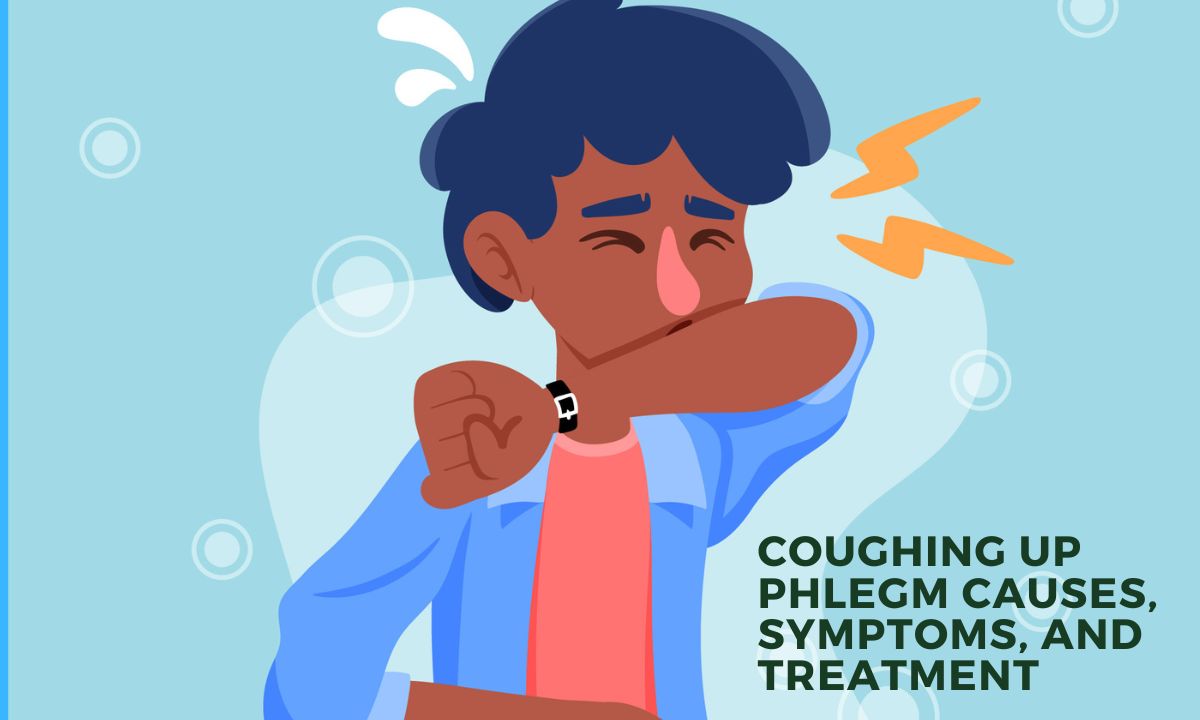Coughing phlegm is a common sign of the body’s reaction to irritation, allergens, or infections in the lungs and throat. It produces a thick substance that differs from nasal mucus. While the expulsion of this mucus is a natural protective mechanism, persistent phlegm may indicate a serious underlying condition.
To receive the best treatment, one must first understand the causes, color, and consequences of coughing up phlegm.
Common Causes of Coughing up Phlegm
Phlegm production is the body’s natural response to irritants, allergens, or infections. It is a protective mechanism that traps and removes foreign agents from the respiratory system. Some of the major reasons for coughing phlegm are:
Viral Respiratory Infections: The flu and the common cold are frequent causes. These viruses attack the respiratory system, causing inflammation and increased mucus production as the body fights the infection.
Bacterial Infections: Bronchitis and pneumonia can be caused by bacteria or viruses. They cause significant inflammation in the lungs’ airways, resulting in phlegm production.
Chronic Lung Diseases: People with lung diseases like asthma, COPD, and bronchiectasis may have more mucus production. Chronic conditions necessitate monitoring mucus changes and seeking medical attention if they persist, particularly among smokers.
Environmental and Lifestyle Factors: Smoking, exposure to air pollution, and alcohol consumption can all worsen phlegm production. These things irritate the lungs, which can lead to chronic respiratory disorders.
Allergies and GERD: Allergic reactions can increase mucus production as the body attempts to eliminate allergens. Similarly, gastroesophageal reflux disease (GERD) causes acid to irritate the throat and lungs, resulting in coughing and phlegm.
Heart failure: can cause fluid accumulation in the lungs, resulting in coughing and phlegm production.
Phlegm Color and its Significance
The color of the phlegm produced when coughing up mucus can indicate a variety of medical conditions. Understanding these colors and their potential causes is crucial.
Clear phlegm: usually indicates healthy lungs, but increasing production may be the body’s way of eliminating irritants. Clear phlegm is normal, but any persistent increase should be noted.
White phlegm: is commonly associated with respiratory conditions such as allergies, asthma, and viral infections. It may also indicate that a chronic lung condition, such as COPD, is not properly managed. White phlegm may indicate an underlying health issue that requires attention.
Yellow or green phlegm: typically indicates a viral or bacterial infection, with the color change caused by white blood cells fighting the infection. Yellow and green phlegm indicate that the body is fighting an illness.
Pink, red, or bloody phlegm: indicates the presence of blood and may be caused by serious conditions such as pneumonia, tuberculosis, or lung cancer. Red phlegm requires immediate medical attention.
Brown or black phlegm: indicates the inhalation of foreign substances such as coal dust or heavy smoke, or the presence of a fungal infection. Black phlegm is especially concerning when combined with pollutant exposure.
Treatment Options and When to Visit a Healthcare Provider
Managing symptoms of coughing up phlegm and determining the best time to seek medical attention are critical components of care. Here are the treatment options and guidelines when consulting a healthcare provider:
Homecare Strategies:
- Use a humidifier to moisten the air and relieve coughing.
- Maintain adequate hydration to help thin the mucus.
- Consider using over-the-counter expectorants to help clear phlegm.
- Gargle with saltwater to soothe the throat.
- Eucalyptus oil has anti-inflammatory properties.
Over-the-Counter Medications:
- Cough syrups and drops can provide symptomatic relief.
- Warm beverages with honey can help soothe the throat.
- Cough medications should not be given to children under the age of six without first consulting a healthcare provider.
When to Consult with a Healthcare Provider:
- If symptoms persist for more than two weeks.
- When phlegm is clear or accompanied by fever, wheezing, or difficulty breathing.
- For persistent coughs, particularly those accompanied by a fever of 101.5°F or higher, chills, or bloody phlegm.
- Severe symptoms, such as choking, coughing up blood, or intense chest pain, should be treated immediately.
Medications Prescribed by Healthcare Providers:
- Antibiotics such as amoxicillin and azithromycin may be required for bacterial infections.
- Asthma and COPD patients may be prescribed allergy medications, inhalers, and corticosteroids.
- Diuretics can be used to alleviate symptoms of heart failure.
Conclusion
If the cough does not improve after ten days or if you have severe symptoms like difficulty breathing, fever, weight loss, coughing up blood, or signs of heart failure, you should see a doctor. Furthermore, if there is an overproduction of mucus for more than four weeks, or if it thickens, changes color, or is accompanied by fever, chest pain, or wheezing, medical advice should be sought. If you cough up blood without phlegm, seek immediate medical attention.
Must Read: https: Diabetic Foot Problems: Causes, Symptoms, and Treatment
FAQs
Q1. What does the presence of phlegm while coughing indicate?
A1. Coughing up phlegm is common with colds and other health conditions. However, if you cough up phlegm but do not feel ill, it could be a sign of a more serious condition like heart or lung disease.
Q2. Which medication is most effective for removing phlegm?
A2. Guaifenesin is a widely used expectorant that effectively relieves chest congestion.
Q3: How do I stop coughing up mucus and phlegm?
A3. To prevent coughing up mucus and phlegm, consider the following strategies:
- Stay hydrated by drinking plenty of fluids.
- Gargle with warm salt water to relieve cold symptoms and excess mucus.
- Keep your head elevated.
- Use a humidifier to moisten the air.
Q4. At what point should I see a doctor about a mucus-producing cough?
A productive cough that expels phlegm or mucus may indicate pneumonia, bronchitis, or influenza. If the mucus is yellowish-green or contains blood, seek medical attention right away.
